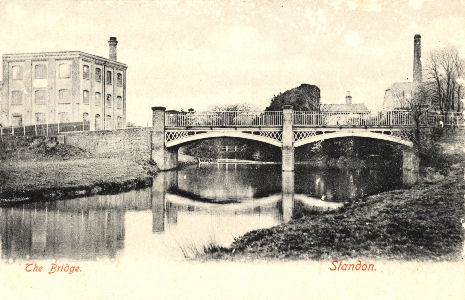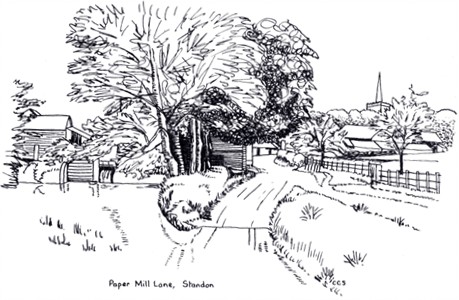Introduction
 |
|
|
The Bridge, Standon (Bedwell series post card) Geograph picture of the Flour Mill (on the left of picture) |
The bridge over the river at the northern end of the village is a county bridge. It was proposed in 1782 to replace the old wooden bridge by a brick one of live arches wide enough for the passage of carriages, so that it might combine with the recent widening of the road from Hadham to Braughing and Standon to improve the communication between Essex and Hertfordshire. The present iron bridge of two arches replaced the brick bridge, which was destroyed by a flood, in 1858. There is a disused windmill to the south of the village; to the north of it close by the railway station is a large flour-mill, built in 1901, which is connected by electric wires with the old water-mill on the other side of the river where the water-power is now supplemented by steam. This was the manorial mill to which the copyholders owed multure. Early in the 19th century there was a paper-mill at the south end of the village (probably on the site of the mill granted to the Hospitallers) which was owned in 1846 by John Parkinson of Lincoln's Inn Fields. It was afterwards used as a saw-mill. The house and water-wheel still remain and the name survives in Paper Mill Lane, Paper Mill Meadow and Paper Mill House.
Standon Millers from trade directories and the census
| 1828 | John & James Smith | millers | ||
| 1839 | John & James Smith | millers | ||
| 1851 | Frederick Smith | miller | ||
| 1855 | Frederick Smith | miller | ||
| 1866 | Garratt & Waller | millers, brewers & farmer | ||
| 1878 | Andrew James Waller | miller, brewer & farmer | ||
| 1895 | Andrew James Waller | miller (steam & water) & farmer | ||
| 1902 | Chapman Brothers | roller miller (steam & water), corn, coal & coke merchants, & agents for the Royal Exchange Fire & Life Office. | ||
| 1929 | Chapman Brothers | flour miller (steam & water), corn, coal & coke merchants, motor engineers (repairs a speciality) & agents for the Royal Exchange Fire & Life Office. TN Puckeridge 3. | ||
| 1937 | British Soya Products Ltd. | food producers, Standon Mill, T.N. Puckeridge 76 |
The census returns tell us that in 1851 Frederick Smith was a miller employing 6 men and 2 boys. In 1861 William Garrett and his brother Andrew James Waller were living in the Mill House, as "Millers & Brewers & Farmers of 126 acres of Land Employing 9 Men and 6 Boys." In 1871 Andrew James Waller was a "Farmer, Miller & Brewer occupying 120 Acres Employing 15 Men and 3 Boys. By 1881 he was described as "Miller & Farmer (375 acres employing 18 men and 5 boys)." The 1891 census is less helpful describing him as "Corn Miller, Coal Merchant & Farmer" but only recording him as an employer. Andrew died in 1897 and in 1901 the Chapman Brothers would appear to be John & Henry Surtees Chapmen, Corn Millers. It would therefore be the Chapman Brothers which built the flour mill (dated 1901) in the picture at the head of this page.
Windmills at Standon
Hertfordshire Windmills & Windmillers includes an extensive account of the Standon smock windmill which was probably disused before 1890 and demolished about 1930. The Windmill Tavern was a 17th or 18th century building used as an inn by 1808 and was still open in about 1962, although now closed. It may have been associated with another windmill which had gone by Victorian times.
Paper making at Standon
 |
Always be on the alert for the unexpected source. This picture of The Old Paper Mill, Standon is on the lid of a tin (late 1930's) which once held Sharp's toffees. |
The following 18th century references are to people listed as papermakers in the Militia lists for Standon: John Bennett (1758-82). Jeremiah Clark (1758-1783), Francis Day (1759-1763), Henry Knight (1764-1784), Thomas Knight (1801), Charles Marshall (1758-1763), Stephen Marshall (1768), William Smith (1779-1792), Richard Whitaker ( 1783-1797, described as master papermaker in 1792), William Whitaker (1792). As rags were used in paper making we should probably also include Richard Goff (rag man, 1763-1773), Joseph Holgate (rag gatherer, 1793-1794) and Thomas Starling (rag man, 1758-1762).
The 19th century trade directories (which did not mention Standon before 1828) show that the Whitaker family were making paper: Richard Whitaker (1828), Martha (1839) and James (1851 and 1855). No paper maker was listed for Standon in 1866.
The 1851 census shows James Whitaker as a paper maker employing 13 men and 9 women - suggesting that it was a very significant business at that date.. However by the 1861 census James (now a 55 year old widower) was described as a retired paper maker. as was his 31 year old son, Joseph Robert Whitaker. It would therefore seem that paper making ceased in Standon in about the late 1850s.
[I have not checked the references to Standon in Paper Mills and Paper Makers in England 1495-1800]
Paper Mill Lane, Standon
from the book A History of the Parish of Standon


